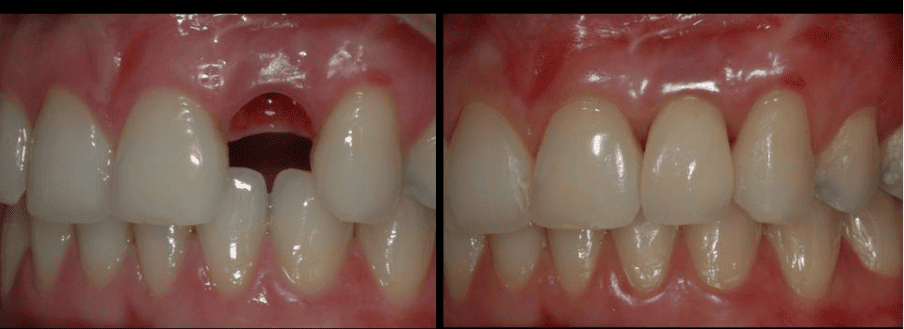The Maryland Adhesive Bridge: The perfect solution and alternative to implants in case of the absence of a single tooth
With its innovative and natural design, this dental bridge offers a highly aesthetic solution to replace one or more missing teeth, either permanently or temporarily (while a dental implant heals).
Unlike other traditional dental bridges, this bridge does not require wearing down adjacent teeth for placement. Instead, it uses a metal or ceramic framework that is bonded to the back of adjacent teeth, meaning there is no need to grind down healthy teeth.
Its beauty lies in its ability to provide a natural and long-lasting appearance. The material used is stain resistant and adapts perfectly to the shape and color of your existing teeth. This ensures that no one will notice the difference between your natural teeth and the bridge.
Remember, Maryland Bridge not only improves your appearance, it also restores full functionality to your mouth. You can talk, eat and laugh with confidence, knowing that your smile will stay bright and beautiful for a long time.
Don’t settle for an incomplete smile. Discover how the Maryland Bridge can transform your dental life.

Table of Content
What is a Adhesive Bridge?
To understand what a Maryland bridge is, we must first define what an adhesive bridge is as a dental prosthetic technique.
An adhesive bridge is a type of fixed dental bridge of one or more pieces, which instead of being supported by a dental crown on a neighboring natural tooth (carved in the form of a stump or abutment), is supported directly on the neighboring natural tooth to which It has been prepared in a minimally invasive way to house a “fin” that is glued with special state-of-the-art adhesives.
This adhesion can be carried out on different surfaces of the tooth:
- On the occlusal side: this is the side that the teeth (premolars and molars) use to chew. When the fin is embedded in a step on the occlusal surface of the neighboring teeth, we speak of a traditional adhesive bridge.
- On the lingual side: it is the side of the tooth that points towards the tongue, that is, it is the innermost side of the tooth. When the fin is adhered to this face, we speak of a Maryland-type adhesive bridge.
So, what is a Maryland bridge?
It is a type of adhesive bridge that is held on the lingual surface of neighboring teeth but using only flattened, medically made structures known as “fins.”
In this way, it is not necessary to carve or wear down the healthy teeth neighboring the site where you want to recover the lost tooth. Only if the fins are made of ceramic or porcelain, minimal wear is necessary to increase the resistance of the structure.
They are a more economical option than implant-supported crowns because it has the advantage of being a fixed bridge and surgery is not necessary to place a dental implant. On the other hand, since it does not have a dental implant to support it, its resistance is lower, so you have to be much more careful.
Is the Maryland Bridge an Adhesive bridge?
Yes, the Maryland is an adhesive bridge, the differentiation lies mainly in:
- Fin shape: Flattened versus stepped
- Location of the fins: lingual aspect versus occlusal aspect
- Number of teeth: usually one versus one or more
- Tooth location: anterior versus posterior sector
Advantages of the Maryland Bridge
- Natural appearance: The material used is stain resistant and adapts perfectly to the shape and color of your existing teeth. This ensures that no one will notice the difference between your natural teeth and the bridge.
- Restores chewing and phonation function: You can talk, eat and laugh with confidence, knowing that your smile will remain bright and beautiful for a long time
- Cheaper than an implant crown: the installation procedure is much simpler, it does not require surgery, which makes it more economical and it can be used temporarily and in case of aesthetic emergencies.
- Minimally invasive: like all adhesive bridges, there is very little wear on neighboring teeth.
- It does not require the preparation of provisionals: by not carving or minimally carving the neighboring teeth, there is no need to protect them with provisional crowns during the process.
- It can be permanent or temporary: It can be used permanently or also temporarily in case of aesthetic emergencies or during the implant placement process; For example, loss of an anterior tooth due to a blow or accident while waiting for the recovery and healing of the dental implant.
Disadvantages of the Maryland Bridge
- It withstands moderate forces: as it is attached to the surface of the neighboring teeth and lacks an implant that serves as a “root”, its resistance is limited to moderate and not high forces, for this reason it is widely used in the anterior sector (incisor teeth). ) that normally support lower forces than molars.
- It works best to replace a single tooth: as a consequence of the previous point, the recommendation is to replace only one tooth so that the fins do not have to withstand high forces.
- Requires greater dental hygiene: having the fins on the back of the teeth, very effective hygiene is required in that area.
How does it work?
The Maryland bridge is placed using a special dental bonding material that ensures a secure and long-lasting hold.
The metal or ceramic framework is bonded to the back of adjacent teeth, creating a strong bond that holds the bridge in place. This technique minimizes the need for invasive tooth preparation and offers a more conservative and less traumatic solution.
Who is a candidate for a Maryland bridge?
The Maryland bridge is an excellent option for those who have lost a tooth (preferably anterior, maximum up to a premolar, depending on the case) and want to restore their smile in an aesthetic and functional way and at a lower cost than a single dental implant.
However, not all patients are ideal candidates for this type of bridge. It is important to consult a qualified dentist to evaluate your individual case and determine if the Maryland bridge is right for you.
There are factors such as sex, age, the quality of the enamel and periodontal status of the neighboring teeth, as well as the patient’s hygiene habits.
Process to obtain a Maryland bridge
The process usually involves several stages, including:
- Initial Consultation: At this stage, your dentist will evaluate your current dental situation, discuss your goals, and answer all your questions about the Maryland Bridge.
- Tooth preparation: If you are a good candidate for the Maryland bridge, your dentist will perform the necessary tooth preparation, which usually involves taking impressions of your teeth and preparing adjacent teeth for bridge placement.
- Bridge Fabrication: Once impressions are taken, they will be sent to the dental laboratory for fabrication of the Maryland bridge customized to your unique dental needs and characteristics.
- Bridge Placement: Once the Maryland Bridge is ready, an appointment will be scheduled for its placement. Your dentist will make sure the bridge fits properly and bond it to your adjacent teeth using a high-quality dental adhesive.
- Follow-up and care: After bridge placement, it is important to follow care instructions and maintain good oral hygiene to ensure the durability and long-term success of the Maryland bridge.
Care and maintenance of a Maryland bridge
Proper care and regular maintenance are essential to ensure that your bridge remains in good condition for many years. Here are some tips for the care and maintenance of your bridge:
- Strict dental hygiene: Brush your teeth twice a day with a soft-bristled brush and floss daily to remove plaque and food debris from around the bridge. Here we leave you an article with greater detail about the best practices in dental hygiene
- Caution: Avoid biting on hard or sticky objects that could damage the bridge.
- Control and follow-up: Schedule regular visits to the dentist for professional exams and cleanings.
- Issues: If you experience any problems with your Maryland bridge, such as an uncomfortable or loose feeling, contact your dentist immediately for assistance.
How long does a Maryland bridge last?
The duration can vary depending on several factors, such as oral care, overall oral health, and the quality of the bridge. However, with proper care and regular maintenance, a well-maintained Maryland bridge can last ten to fifteen years or even longer.
Cost of a Maryland Bridge
The cost can vary depending on several factors, such as the complexity of the case, geographic location, the dentist’s experience and the preparation material. It is important to consult with your dentist to obtain an accurate quote and understand the financial details before proceeding with treatment.
In Quito, Ecuador is one of the places where you can opt for dental treatments at affordable prices.
Other options besides the Maryland Bridge
While the Maryland bridge may be an excellent option for many patients, there are alternatives that may be more suitable in certain cases. Some of the common alternatives including
- Crown on dental implant: it is the most effective, durable 1 and resistant option
- Adhesive dental bridge: they can be used in case of posterior teeth (molars) that require more resistant support
- Removable partial prosthesis: usually applied if you have several missing teeth
It is essential to discuss all options with your dentist to find the best solution for your specific dental situation.
Conclusions
The Maryland bridge offers an aesthetic and functional solution for those who want to restore their smile and replace missing teeth. With its innovative design, high-quality materials, and ability to preserve adjacent teeth, the Maryland bridge provides long-lasting, natural results.
If you are looking for a reliable and aesthetic solution for your smile and cannot afford a dental implant, consider the Maryland bridge as an excellent option, whether temporary or permanent.
Consult your dentist to learn more and take the first step toward a bright, long-lasting smile. Don’t settle for an incomplete smile!
References
- Balevi, B. Root canal therapy, fixed partial dentures and implant-supported crowns, have similar short term survival rates. Evid Based Dent 9, 15–17 (2008). https://doi.org/10.1038/sj.ebd.6400565 ↩︎





